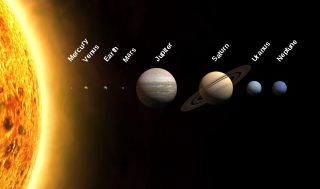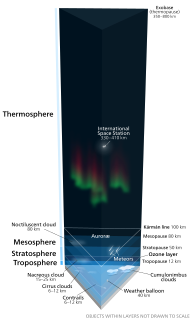Related Research Articles

Gram-negative bacteria are bacteria that do not retain the crystal violet stain used in the gram-staining method of bacterial differentiation. They are characterized by their cell envelopes, which are composed of a thin peptidoglycan cell wall sandwiched between an inner cytoplasmic cell membrane and a bacterial outer membrane.

The Oort cloud, sometimes called the Öpik–Oort cloud, first described in 1950 by Dutch astronomer Jan Oort, is a theoretical cloud of predominantly icy planetesimals proposed to surround the Sun at distances ranging from 2,000 to 200,000 au. It is divided into two regions: a disc-shaped inner Oort cloud and a spherical outer Oort cloud. Both regions lie beyond the heliosphere and in interstellar space. The Kuiper belt and the scattered disc, the other two reservoirs of trans-Neptunian objects, are less than one thousandth as far from the Sun as the Oort cloud.

The Solar System is the gravitationally bound system of the Sun and the objects that orbit it, either directly or indirectly. Of the objects that orbit the Sun directly, the largest are the eight planets, with the remainder being smaller objects, the dwarf planets and small Solar System bodies. Of the objects that orbit the Sun indirectly—the natural satellites—two are larger than the smallest planet, Mercury.

A ring road is a road or a series of connected roads encircling a town, city, or country. The most common purpose of a ring road is to assist in reducing traffic volumes in the urban centre, such as by offering an alternate route around the city for drivers who do not need to stop in the city core.

Outer space is the expanse that exists beyond Earth and between celestial bodies. Outer space is not completely empty—it is a hard vacuum containing a low density of particles, predominantly a plasma of hydrogen and helium, as well as electromagnetic radiation, magnetic fields, neutrinos, dust, and cosmic rays. The baseline temperature of outer space, as set by the background radiation from the Big Bang, is 2.7 kelvins. The plasma between galaxies accounts for about half of the baryonic (ordinary) matter in the universe; it has a number density of less than one hydrogen atom per cubic metre and a temperature of millions of kelvins. Local concentrations of matter have condensed into stars and galaxies. Studies indicate that 90% of the mass in most galaxies is in an unknown form, called dark matter, which interacts with other matter through gravitational but not electromagnetic forces. Observations suggest that the majority of the mass-energy in the observable universe is dark energy, a type of vacuum energy that is poorly understood. Intergalactic space takes up most of the volume of the universe, but even galaxies and star systems consist almost entirely of empty space.

The bacterial outer membrane is found in gram-negative bacteria. Its composition is distinct from that of the inner cytoplasmic cell membrane - among other things, the outer leaflet of the outer membrane of many gram-negative bacteria includes a complex lipopolysaccharide whose lipid portion acts as an endotoxin - and in some bacteria such as E. coli it is linked to the cell's peptidoglycan by Braun's lipoprotein.

The following outline is provided as an overview of and topical guide to space exploration:
Steniodes is a genus of moths of the family Crambidae described by Snellen in 1875.
Steniodes acuminalis is a moth in the family Crambidae. It was described by Harrison Gray Dyar Jr. in 1914. It is found in Panama and Costa Rica.
Steniodes deltoidalis is a moth in the family Crambidae. It was described by Snellen in 1875. It is found in Colombia.
Steniodes dominicalis is a moth in the family Crambidae. It was described by Schaus in 1924. It is found on Dominica.
Steniodes gelliasalis is a moth in the family Crambidae. It was described by Francis Walker in 1859. It is found in Brazil, Colombia and the West Indies, where it has been recorded from Jamaica.
Steniodes mendica is a moth in the family Crambidae. It was described by W. von Hedemann in 1894. It is found in Cuba, Jamaica, Puerto Rico, the Virgin Islands and Grenada, Costa Rica, Honduras, Mexico and the United States, where it has been recorded from Florida to Texas.
Steniodes nennuisalis is a moth in the family Crambidae. It was described by Schaus in 1924. It is found in Peru.
Steniodes suspensa is a moth in the family Crambidae. It was described by Edward Meyrick in 1936. It is found in Venezuela.
Steniodes costipunctalis is a moth in the family Crambidae. It was described by Snellen in 1899. It is found in Indonesia (Java).
Husk in botany is the outer shell or coating of a seed. It often refers to the leafy outer covering of an ear of maize (corn) as it grows on the plant. Literally, a husk or hull includes the protective outer covering of a seed, fruit, or vegetable. It can also refer to the exuvia of insects or other small animals left behind after moulting.
For old National Highway 230,refer to National Highway 85 (India).
Steniini is a tribe of the species-rich subfamily Spilomelinae in the pyraloid moth family Crambidae. The tribe was erected by Achille Guenée in 1854.
References
- ↑ "GlobIZ search". Global Information System on Pyraloidea. Retrieved 2014-07-15.
- ↑ BOLD Systems
- ↑ Steniodes at Markku Savela's Lepidoptera and Some Other Life Forms
- ↑ Proceedings of the United States National Museum 47 (2050): 286
| This Steniini-related article is a stub. You can help Wikipedia by expanding it. |